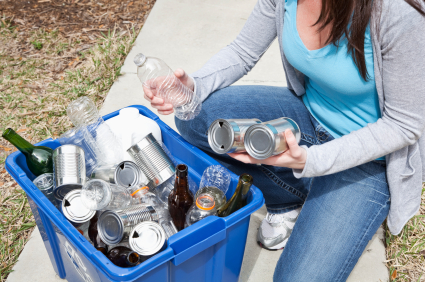Our friends at LearnVest offer sound financial tips and advice for every aspect of life. Check out these zero-waste strategies everyone should know about.
Five years ago, Bea Johnson and her husband and two sons were looking for a home closer to the restaurants, shops and school in their coastal California town.
During the year they spent house hunting, the family of four moved into a small apartment, took only the possessions that were absolutely necessary, and left the rest in storage.
“After living with just the necessities, we realized that we had much more time to spend with our family when we weren’t spending it caring for a large house and lots of belongings,” says Johnson.
Then, when they did decide on a house, they chose one half the size of their previous home, and simplified by selling most of their old stuff.
Around that time, Johnson and her husband began investigating environmental issues. “We read books, watched documentaries, and what we learned worried us and made us sad for our kids’ futures,” she says. “So, we decided to do something about it. My husband quit his job to start a sustainability consulting company, and I tackled greening our house.”
It was then that Johnson devised a system to reduce the family’s garbage — what she calls the “Zero-Waste Home.” She started by swapping everything disposable in their home (paper towels, water bottles, grocery bags) for reusable items.
Today, she says, her family’s yearly waste can fit in a quart-size jar.
She spoke with us about how to get started, her zero-waste strategies and the one sustainable habit she’s just not down with.
LearnVest: Was there something you read or saw that you modeled your Zero-Waste Home after?
Johnson: No. Actually, there were no blogs or really anything about being zero-waste, so I had to test everything for myself — I did a lot of Googling. Today, the zero-waste lifestyle is easy for us — we don’t even think about it. But [when we were getting started], we had to experiment to find what our limitations were.
LearnVest: What are the basic tenets of the zero-waste lifestyle?
Johnson: What we do is based on what we call “The Five R’s,” which should be applied in order.
No. 1: Refuse whatever we do not need. For example: junk mail and freebies.
No. 2: Reduce what we do need by donating or selling anything that isn’t absolutely necessary for us to live comfortably.
No. 3: Reuse by buying secondhand, swapping disposable items for reusable items, and shopping with reusable packaging.
No. 4: Recycle. By this point, if you’ve applied the first three R’s, you should be left with very little recycling. For example, what’s left in our recycling bin are bottles of wine that friends bring over and papers sent home from our sons’ school.
No.5 : Rot. Compost anything that can be composted.
LearnVest: How did your sons react to the change in your lifestyle?
Johnson: Our sons [ages 13 and 11] didn’t even know we were doing zero waste until we pointed it out to them. To them, what we do is totally normal. And, the kids have really enjoyed the simplicity aspect of the lifestyle. It clears their heads, keeps them focused, and they say it’s much easier to clean their rooms.
LearnVest: What is your process for grocery shopping?
Johnson: For my weekly grocery run, I bring what I call my shopping kit: three totes, five glass jars (one each for meat, fish, solid cheese, grated cheese and deli meat for the kids’ lunches), two different sizes of cloth bags for dried bulk goods and mesh bags for produce.
I buy olive oil, honey, peanut butter, cereal, snacks — almost everything — from the bulk section in our grocery store where the items are unpackaged. I buy grated cheese from the salad bar and, every week, I ask for 10 baguettes unpackaged from the bakery. I put them in a pillowcase and then cut them in half, freeze them and thaw them out as needed. The produce section is also great for unpackaged foods. The only food that my family eats with disposable packaging is butter — that’s it. We tried making our own butter, but we found that it was not a sustainable option for us.
Continue reading Johnson’s take on zero-waste living on LearnVest.
More from LearnVest:
- 6 Ways to Save Money — by Going Green
- How an Energy Audit Saved Us $2,400 a Year
- 7 Ways You’re Wasting Money … Every Day
This post originally appeared on LearnVest.com on April 22 and was written by Lisa M. Gerry. It is republished here with permission from LearnVest.
Note: The views and opinions expressed in this article are those of the author and do not necessarily reflect the opinion or position of Zillow.
Creating a Zero-Waste Home | Chappaqua NY Real Estate
Leave a reply
via zillowblog.com

